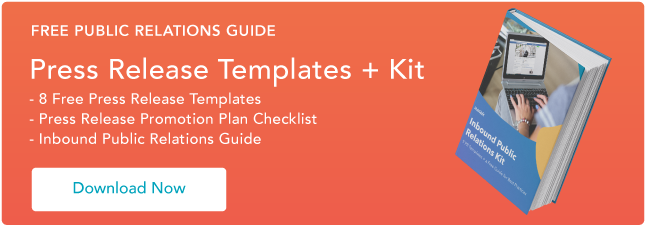- Like
- SHARE
- Digg
- Del
- Tumblr
- VKontakte
- Flattr
- Buffer
- Love This
- Save
- Odnoklassniki
- Meneame
- Blogger
- Amazon
- Yahoo Mail
- Gmail
- AOL
- Newsvine
- HackerNews
- Evernote
- MySpace
- Mail.ru
- Viadeo
- Line
- Comments
- Yummly
- SMS
- Viber
- Telegram
- JOIN
- Skype
- Facebook Messenger
- Kakao
- LiveJournal
- Yammer
- Edgar
- Fintel
- Mix
- Instapaper
- Copy Link
Press releases remain a critical link in the communications chain. According to Cision’s 2021 Global State of the Media Report, 78% of journalists say they prefer press releases and news announcements to other content types.
The problem? Writing a press release is simple — writing a good press release is no easy task. In this piece, we’ll break down 14 common bad press release characteristics and offer suggestions to help your team avoid press release mistakes.
14 Rookie Press Release Mistakes to Avoid
While there’s no such thing as the “perfect” press release, your team can get closer to the mark by avoiding common errors. Here’s a look at 14 of the most common rookie mistakes — and how to reduce your chance of making them.
1. Forgetting to Add Links
Press releases are not just for the press. Releases will likely be published on your website, and your team might also submit releases to wire services. The result? Press releases now live in a digital world — and they need links that drive readers to other relevant content. For marketing teams still using the traditional model of press release production, however, it’s easy to miss out on links.
The result is a release that might have great content but doesn’t go anywhere, meaning your team can miss out on potential conversion opportunities.
The Solution: Ensure all press releases are reviewed prior to publishing. If there’s no obvious place for a link, revise the release to include it.
2. Not Optimizing for Search Engines
Not only should you have links to your company website, you should also craft the “link text” (or “anchor text”) of some of these links so that they contain relevant keywords for SEO (Search Engine Optimization) purposes. For example, if you are in the internet marketing software business, you would have a link in your press release somewhere such that the text of the link has internet marketing in it. On a related note, the page that you are linking to should have matching keywords in its page title and meta description.
The Solution: Check your press releases for SEO relevance using tools capable of measuring the impact of your content and offering suggestions before you publish.
3. Putting Your First Link Too Late
Try to get at least one link in the first third of your content. The reason for this is that when releases get picked up by aggregators or services, they often only include just the first paragraph or two, and the rest gets automatically placed into a subsequent page with a “read more” button.
The result? You might have two or three great links in your content that never see the light of day because readers are only skimming the first few lines of your press release.
The Solution: If you can’t find a place for links in the top third of your content, opt for a rewrite rather than running the risk of burying the link after the jump.
4. Not Including Contact Information
No contact information in your press release — including a phone number and email address — means interested parties have to do the work of looking up your company details and following through. While the effort here isn’t substantial, it’s often enough that potential contacts will simply forget about finding your number or will connect with companies that make their contact information more obvious.
The Solution: Make sure every release includes at least two ways for customers to get in touch — and make sure both still work. There’s nothing worse than sending out an email address that bounces back messages because it’s no longer active.
5. Leaving Out the “About Our Company” Section
Sure, most people aren’t going to read all the way through to the bottom of your press release. But those that do are primed to connect with your company, if you can provide the last little push into action.
This is where the “About Our Company” section comes in. It doesn’t have to be complicated, just a small blurb about what you do and why you do it, but it’s worth including in every press release.
The Solution: Create an About Our Company section that’s clear, concise, and to the point. Then, regularly review it to ensure it’s up-to-date.
7. Ignoring the “Why”
Why should readers care about your press release? What’s newsworthy or interesting about your announcement? While it’s critical to communicate key information, the message also matters: Dry, dull, and boring press releases may get published — but they won’t get read.
The Solution: Lead with a compelling headline and first paragraph. Even if your release gets more detailed as it goes, capturing user attention up-front increases the chance that readers will actually reach the end.
8. Using Uninspiring Quotes
While it’s great to have quotes from executives or team leaders at your company, it’s worth steering clear of quotes from executives or team leaders that talk about how “excited” or “proud” they are about the information in your release. Why? Because these quotes don’t add any value. Of course staff at your company are interested in your announcement, but that doesn’t offer any insight for journalists or readers.
The result is a press release that looks like a carbon copy of similar content and won’t get much traction.
The Solution: Where possible, talk to the people involved with the project or product you’re announcing and get quotes about why it matters to the target audience — what pain points can it address? How does it transform existing processes?
9. Over-Emphasizing Your Brand
Your press release is about your brand — but it shouldn’t be all about your brand. If all you do is talk about how great your company is and how much work you’ve done, you’re not giving readers any reason to keep reading. Instead, they’re left wondering how much of what you’re saying is true and how much is hyperbole.
The Solution: Press releases are about walking the line between promoting your brand and highlighting the impact of your newest project, service, or research. A good rule of thumb? Make sure the headline and first paragraph are about what you’ve done, not how great you are.
10. Under-Supporting Press Release Promotion
Press releases are part of larger marketing campaigns. As a result, it’s easy to spend big on other efforts such as social media and search ads, and under-support press releases. This creates a gap in your marketing efforts that reduces the newsworthy impact of your announcement.
In practice, this limits the reach of your campaign and can frustrate efforts to generate market interest.
The Solution: Start with strategy. Sit down with your team before new campaigns get up and running to ensure there’s a plan for press releases that includes specific budget allotments and targeted news sources.
11. Opting for Style Over Substance
Creating a great headline and compelling first paragraph is a great way to get readers interested — but you’ll lose them in the next section of your press release if you can’t back up initial style with substance.
Consider a press release about a new product that claims to solve specific issues for your target audience. If you spend the first two paragraphs talking about the potential positive impact but don’t back it up with data, quotes, or other evidence, your press release won’t land.
The Solution: Start with solid data. Talk to your product teams and evaluate your market to see where your new solution fits and then find specific data that showcases your results.
12. Forgetting to Ask for Permission
Quotes are a great way to connect with your audience and increase the impact of your press release. The caveat? Always get permission. Internally, this is typically no issue, but if you’re using quotes from a third-party source, even if they’re directly and positively talking about your product, make sure to get express written permission.
If you don’t — and the source doesn’t want their quote used — you could end up doing serious damage to your reputation.
The Solution: Create a clear permissions process that involves identifying great quotes, reaching out to sources, and getting express permission in writing to ensure you’re on solid source ground.
13. Rushing the Release
Timing is everything when it comes to press releases. While it’s tempting to get your release out as soon as possible, if your release goes out before the rest of your campaign is ready, you may find yourself turning away potential customers until your product or service is actually ready for launch.
Best case scenario? You play catch-up and customers stick around. Worst case? They take their business elsewhere.
The Solution: Create a marketing timeline for new campaigns that specifically calls out press release dates and aligns them with other campaign efforts.
14. Trading Accuracy for Speed
The more quickly you can capitalize on emerging trends and customer sentiment, the better. The challenge? Trading press release accuracy for speed. If your release goes out on time but is riddled with spelling or grammar errors, it won’t have the same impact and could convince customers to take their business elsewhere.
The Solution: Put every release through at least two rounds of edits and evaluation to minimize mistakes.
Don’t Stress — Impress By Avoiding Common Mistakes
A bad press release can sink your marketing campaign. Improve your impact and cultivate a strong brand presence with your audience by avoiding these 14 common mistakes.
Editor’s note: This post was originally published in May 2022 and has been updated for comprehensiveness.
Originally published Jun 10, 2022 7:00:00 AM, updated June 10 2022



